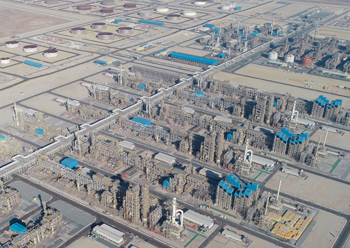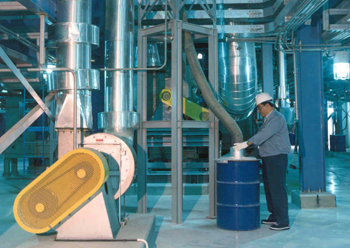
 KCCI chairman Muhammad Al-Saqer
KCCI chairman Muhammad Al-Saqer
With the rebound in crude prices on the back of rising geopolitical tensions surrounding Russia and Ukraine, Kuwait’s hydrocarbon exports (90 per cent of total merchandise exports) will continue to remain an important source of revenue. However, it is non-oil activity that is driving growth forecasts of one of the world’s largest oil producers and exporters economy.
According to National Bank of Kuwait, the country’s non-oil sector recovery continued in the final quarter of 2021 (4Q21), primarily driven by robust consumer spending, real estate, stock market activity as well as pick up in the projects market.
The bank in its latest quarterly economic brief (February 2022) estimated that the improvement in both oil and non-oil fundamentals could see headline Gross Domestic Product (GDP) growth accelerate to 7 per cent in 2022 from around 1.0 per cent (estimated) in 2021.
 |
|
The upcoming Al-Zour refinery project in Kuwait is one of the biggest projects being implemented in the country |
Likewise, data from a report on the most important statistical indicators that reflect the achievements made by Kuwait in its developmental process, indicated that the contribution of the non-oil sector amounted to 65.8 per cent of the GDP in 2020, while the contribution of non-oil revenues to the total government revenues reached 16.5 per cent in 2020 compared to 11.4 per cent in 2015.
“Sustainable development is one of the most important economic trends followed by Kuwait, which constantly seeks to diversify its production base and national income sources,” pointed out the report issued by the Statistical Centre for the Gulf Cooperation Council (GCC-STAT) to coincide with Kuwait’s celebration of its 61st National Day on February 25.
World Bank in its report predicted that Kuwait’s economy is set to grow by 5.3 per cent in 2022, followed by a 3 per cent growth the next year. According to Kuwait’s Central Statistical Bureau, Kuwait’s nominal GDP for 2020 was $118.8 billion. In 2021, the Central Bank of Kuwait announced that Kuwait’s GDP had contracted 9.9 per cent in 2020 from 2019 mainly due to sharp decrease in oil prices.
KEY CHALLENGES
An uptick in non-oil sector will augur well for the Kuwaiti economy which is characterised by two major structural imbalances – heavy dependence on oil production and dominance of the public ownership, industry analysts said.
“Kuwait has struggled over the years to implement a two-pronged development strategy – diversifying the country’s economic base away from the oil sector and promoting private sector development,” a paper titled `Diversifying a resource-dependent economy: private–public relationships in the Kuwaiti economy’ published on Journal of Economic Structures noted.
In fact, Kuwait economy’s heavy dependence on oil and domestic consumption, and slow progress in the implementation of Kuwait Vision 2035 and the economic diversification plans, are largely seen as the main long term challenges.
The oil industry and government sector dominate the economy, with crude oil reserves estimated at nearly 101.5 billion barrels, or approximately 7 per cent of the world’s reserves. The oil industry accounts for over half of GDP and 90 per cent of government export revenues. With oil the main natural resource, oil refining, and downstream petrochemical processing are the dominant industries. Non-petroleum manufacturing and agricultural sectors are limited, consisting of a switch-gear manufacturer for power sub-stations, and factories for building materials, furniture, and food packaging.
Kuwait imports most of its capital equipment, foods, manufacturing equipment, and consumer goods. Two-way trade is limited to a few international partners. Almost half of the country’s imports originate from China, the US, the UAE, Japan, and Germany, while over 50 per cent of Kuwait’s export earnings are attributable to South Korea, China, India, Japan, and the US.
DIVERSIFICATION PROGRESS
Launched in 2017, objectives of Kuwait Vision 2035 include upgraded infrastructure and diversification of the economy away from oil. It is focused on economic reform designed to empower the private sector and transform Kuwait into a regional trade and investment hub. However, the majority of government-funded projects move slowly.
“The third development plan 2020-2025 was launched to meet these goals but implementation has been slow. Large financial assets underpin Kuwait’s economic resilience, but these assets alone cannot substitute for the fiscal and structural reforms that would offset the risks of lower oil prices, low oil demand in the future, and rising marginal cost of production. Such reforms include non-oil revenue mobilisation, enhancing human capital, and reforming economic governance to invigorate private sector-led development,” World Bank in its country analysis of Kuwait noted.
“Non-oil growth is stalled due to short-term challenges related to the fallout from the coronavirus pandemic, and structural problems such as the lack of a dynamic private sector, compounded by political barriers to structural reform,” it added.
However, this may be beginning to change with Kuwait Vision 2035 set to transform the country into a centre for finance and trade, led by a rejuvenated private sector, more public-private partnerships and a higher level of infrastructure spending.
According to the GCC-STAT report, Kuwait seeks to develop the investment climate, attract foreign direct investment (FDI) as an important source of financing development activities and to increase the role of the private sector in supporting economic growth. In this context, the total FDI balance increased during the past years to $45.7 billion by the end of 2020, compared to $42.8 billion in the previous year, with an increase of 7 per cent.
 |
|
A file photo of Kuwait Catalyst Company’s plant in Kuwait |
The World Bank report too, emphasises that the economic growth underscores the contribution of high oil prices to the national budget of the country, and the importance of developing the private sector and human capital for achieving sustainable economic growth.
Towards that, chairman of the Kuwait Chamber of Commerce and Industry (KCCI) Muhammad Al-Saqer recently said that the private sector, with its various commercial and industrial companies and institutions, is a major contributor to the Kuwaiti economy and many development sectors, stressing the importance of the private sector in the comprehensive development in Kuwait, strengthening the sector’s income, economy and government efforts in general, specifically in the health area.
OUTLOOK
Further, as per a risk assessment by Coface for Trade, a reference in credit insurance and risk management, recovery is expected to be gradual.
“In line with the opening up of the economy, private consumption (about 40 per cent of GDP) reached almost a decade-high level in 2021. It should continue expanding in 2022 as well, but at a slower pace because of the maturing recovery and fading base effect,” Coface said in its country risk report on Kuwait.
“Exports will become the key contributor to growth. Indeed, oil production will rise by nearly 13 per cent in 2022 after falling in 2020 and 2021 consecutively due to the OPEC+ agreement,” it predicted.
Due to the lack of economic diversification, trends in the oil sector will continue to be determinant for the Kuwaiti economy. Thanks to the rise in oil prices and increased global hydrocarbon demand, net exports will support growth in 2022, the report estimated.
Investments (20 per cent of GDP) will inch up in 2022 on the back of the completion of several refineries, such as the Al-Zour refinery project, and LNG import facilities. Other construction projects, such as the development of Sheikh Jaber Al-Ahmad Al-Sabah Causeway, within Kuwait’s 2035 Vision programme will also sustain investments.
Government spending will also edge up in 2022, in line with higher oil prices and national savings (30 per cent of GDP), which will alleviate pressure on the government to restrain expenditure, like cutting the public sector wage bill or introduce revenue measures such as a 5 per cent VAT, Coface report added.












